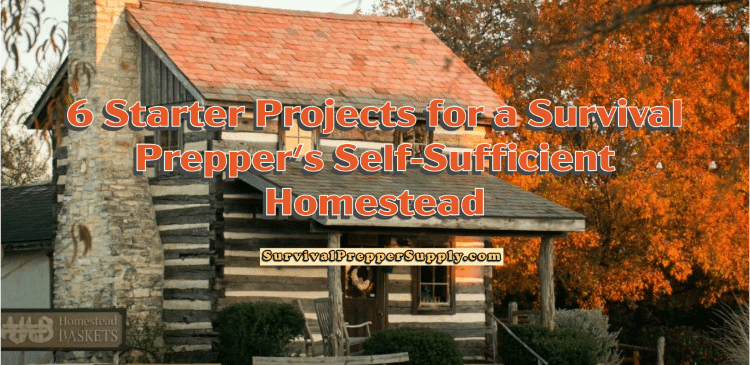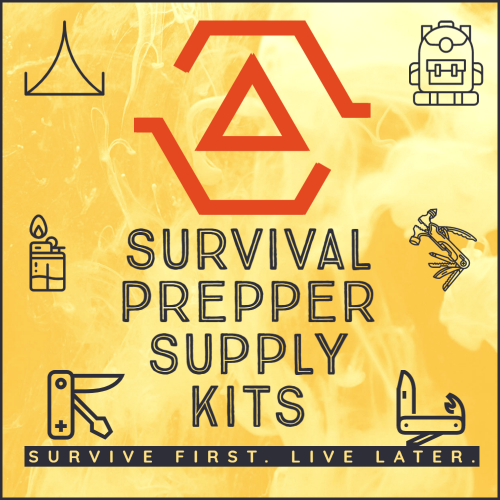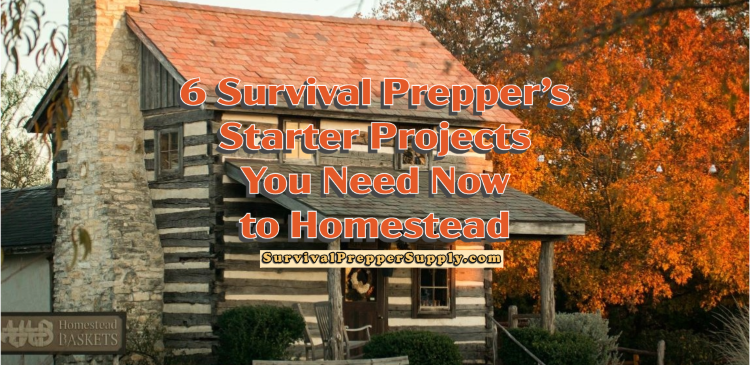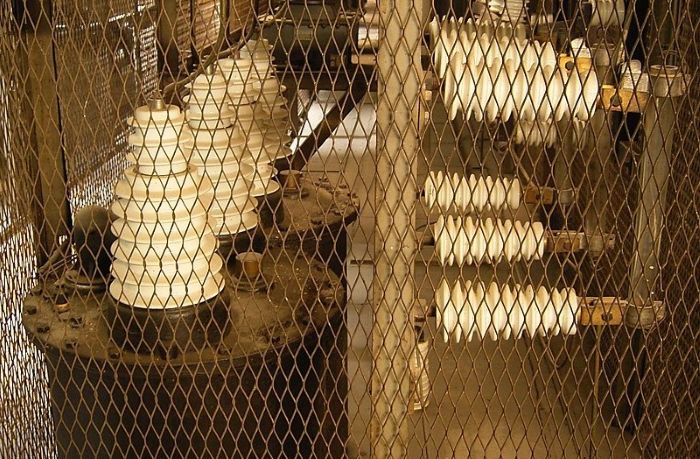Survival Prepper ’s Homesteading Starter Projects

Embarking on a homesteading adventure as a
The key is knowing where to start once you have scouted the right land and built your homestead shelter. Moving onto the land is a step towards understanding the lifestyle. When you become accustomed to the lifestyle, visiting the land is important. It allows you to see what this lifestyle entails.
You want to practice situations that allow survival on and off the grid. This helps cut expenses and achieve self-sustainability. Moreover, it provides knowledge about tasks we rely on others for.
Knowing which projects to start with allows you to fast-track your ability. You won’t have to rely on a supply chain or professionals. They won’t have to rescue you from dire situations. As a new homesteader, you’ll find six projects below. These projects will give you a good grasp on living this way and what you need to learn more about.
1 Water Collection and Usage Plans for Your Property
You will need to handle the collection and use of water on your new homestead property. This is one of your first and most important projects. Ideally, you will have a natural water resource on your land, but that’s not always possible.
You can harvest water from a spring, river, lake, or pond. These natural water sources must not dry up. You may also be able to drill a well on your property if there is groundwater located nearby.
You want to set up a method of collecting rainwater so that you can use it whenever you need it. To harvest rainwater, you need a storage tank and a way to collect and channel the water. You can do this by capturing the runoff from your roof.
Related – A Survival Water Storage Guide to Using Rainwater for Simple Living
Some people also like to have a greywater system for their homestead. You can reuse water from laundry, dishes, baths, and more. Grey water is a name for this water. It is appropriate for flushing toilets or watering plants. You can use it on your property. Make sure the ingredients in the soap or detergent are safe.
First, make sure you have a well-defined method for collecting. Next, determine how you will apply this method on your homestead. Of course, you want to have a way to have safe drinking water for yourself and your family.
Related – Bushcraft – Part 3 Safe Water for Survival
That’s the most essential part of this project. You also need to be able to provide fresh water for your livestock animals. Ensure that the troughs or watering systems receive clean, drinkable water.
Some homesteaders install water treatment systems to purify collected water. The systems remove contaminants, making the water safe for cooking and drinking. Next, you must have a watering system for irrigating your garden.
You can create a system to use household water for various tasks. This includes washing dishes, washing clothes, flushing toilets, bathing, and cleaning. The most obvious water usage methods are these. There is another one to consider: emergencies.
In case of a fire or drought, having abundant water is crucial. It can help protect your home, property, and family from harm.
Setting up these systems is a great way to get started with your most essential survival needs. But you might run into some problem areas that you need to be ready for, too. If there is not enough water where you are, save it. Consider getting a larger tank with more water and various ways to fill it.
Your storage containers might become compromised. Extreme heat and extreme cold weather can both cause cracks and leaks in storage tanks. Thus, it is important to watch them and address any issues. This will help prevent contamination or loss of your water.
Livestock can contaminate the water source with manure. Keep an eye on this. Make sure you hydrate your livestock. Don’t let them cause bacterial contamination in your water source.
2 Food Growth and Storage Set-Up
Food is a major concern for survival preppers like you. Your shelter and water are already taken care of. When homesteading, think about the projects for food growth and harvest storage. Consider your desired undertakings.
The first thing you must do for this project is find out what growing zone you live in. Look up the USDA plant hardiness zone map. It shows your growing zone. This helps you choose appropriate plants and planting times.
The next thing you have to do for this project is analyze your soil. You can check the pH levels and nutrient deficiencies of your soil. DIY kits or professional testing can guide you for optimal growth.
You’ll want to take time to map the layout of your garden. Consider the space needed for each full-grown plant. Plan companion planting accordingly. Account for sunlight requirements.
You may also want to plan space for berry bushes and fruit trees on your property. You can do these activities in two different places. One is the perimeter, and the other is a location with enough sunlight and space for irrigation.
Next, set up your irrigation system to keep your vegetation hydrated. You may want to install the pipes or hoses before you go through the planting process.
You want to gather all the products you’ll use to care for your plants. This includes fertilizer, mulch, and other necessary items. If you want to start a compost bin to help enrich the soil, now is the time.
Before purchasing seeds or seedlings, planning for year-round harvest is vital. By doing so, you can ensure that your food will ripen and be available throughout the year. There are cold weather harvests as well as warm weather harvests.
Consider soil fertility when planning crop rotations, ensuring richness for each new crop. When planning, you might consider weather conditions, such as when you will get the most rain or sun.
When homesteading for survival, prioritize high-yield, nutrient-rich crops for your family’s food.
Potatoes are always one of the best crops to grow for survival. Not only are they easy for new homesteaders to grow, but they store well and for an extended period of time. When it comes to nutrients, this is a high-carb food that is going to provide you with potassium and vitamin C.
Consider growing carrots, turnips, parsnips, beets, onions, and radishes in your garden. These root vegetables are great for homesteads. These will all store well in your root cellar or storage bins and are easy to grow.
Beans are another great survival crop you want to grow and harvest. This is another option for long-term storage. It provides protein, carbohydrates, and fiber.
Consider growing some peas in your homestead garden, too. Again, grow this crop easily for vitamins A and C. Store and use it conveniently in various ways.
If you are in a dry location, you may not want to plant certain vegetables, such as squash. These plants require regular watering. If you have abundant water, it’s a perfect plant for various purposes.
You want to have a lot of greens being grown in your homestead garden. Some are easier to grow than others. For example, lettuce and spinach are simple to nurture.
You may also want to grow kale, collard greens, mustard greens, and other items. Don’t forget to grow your own herbs, too. These spices flavor your meals, and some have medicinal benefits. Plus, you can dry and store them.
Tomatoes are another great survival crop. They are easy to grow. You can store them by canning or dehydrating them. You can use them in many different recipes.
You can plant berry bushes like blueberries, blackberries, strawberries, and raspberries. These bushes offer extra vitamins and antioxidants for your property. You can eat these fresh or turn them into flavorful jellies and jams. They enhance the taste of breads, biscuits, and more.
You may want to plant some fruit trees on your property. Have a mix of stone fruit and citrus fruits. Oranges, lemons, peaches, apricots, and other trees are perfect. They deliver a bounty for your family year after year.
Start the learning process. Know when to plant on your property. Learn how to water and provide nutrients for your plants. Know when to harvest. Understand what to do after that process.
When you harvest your garden, think about what you need now and what you can store. You have to begin the education process to learn all these food preservation methods.
Some of the most important ones you’ll want to consider are canning and dehydrating. You can freeze food if you have power for your property.
There are different ways to dry food, such as using a dehydrating machine or air drying it in the sunlight. You have to know how to store it properly in an airtight container to keep it from spoiling after this process.
You may also want to learn how to use fermentation to preserve certain foods. For instance, you can turn cucumbers into pickles. Additionally, you can create foods like kimchi and sauerkraut. These foods promote good health for your gut.
Over time, you might encounter various issues hindering your growth. These issues can also impact your ability to produce a good harvest. Consistently check soil fertility to monitor nutrient levels and plan accordingly. Rotate crops or add compost to enrich depleted soil nutrients.
Some individuals disregard harvest guidelines and guess about food harvesting times. To maximize your garden’s yield, learn when to harvest crops. Use guidelines and visual cues for timing.
Another problem many people run into is diseases such as mildew that can ruin your plant’s health. You might also encounter pests that harm your crops. They can be insects or rodents that eat plants.
You might also encounter a weather event that harms your crops. We won’t have a weather app to help us know what the weather is. You should prepare for situations like a lack of rainwater or floods. Also, consider the possibility of cold or hot temperatures. Make plans for these situations in advance.
You may or may not have the ability to buy seeds. Keep in mind that you want to plant the next round of crops. You want to learn how to save, label, and store harvested seeds. This way, you won’t need to buy from another source.
3 Homestead Cooking and Chores
Cooking on a homestead is different from cooking in the suburbs. Cleaning is also different. In the suburbs, you have access to everything you need.
We’ll discuss cooking in more detail shortly. Besides, you need to know how to clean using natural products. You can make window cleaners, counter cleaners, and wood polishing products.
You may also have different things you need to clean now. You might have a wood oven that needs more effort. An electric one is easier; press a button, and it cleans itself.
You’ll need to know how to conduct your chores without these conveniences. You can wash clothes by hand instead of using a washing machine or dryer. Then, dry them by hanging them outside in the sun.
Your waste management system may be different when you are on a homestead. You may do more composting and recycling than you have before. In a survival situation, you might not have access to professionals. It’s important to know how to repair and maintain your home.
Some people change their entire lifestyle, which includes cooking without modern conveniences. To use this method, learn to cook over an open fire. Or, use a wood stove or solar cooker for meal preparation.
You may want to become adept at Dutch oven use, where you will use a cast iron container to cook with. You can cook meats, breads, and other items over an open fire.
You must learn cooking methods. You should practice making homemade items. You may not have access to them in the future.
Baking your own bread is easy. You need to learn how to do it from scratch. It requires flour, yeast, salt, and water. Or, you may want to make other baked goods like cookies, cakes, or muffins.
Decide whether you want to make butter or prepare items like cheese, yogurt, and sauces at home for meals.
Create a list of your family’s beloved foods. Consider how to cook them without a nearby grocery store.
4 Necessary Crafts to Support Your Homestead
You want to start a new project for your homestead. This project involves learning crafts that will support your new way of life. You can start with any of these and master one of them before moving on to the other.
Your first option is to start learning woodworking and carpentry. You can use this to construct a shed or chicken coop. Additionally, it helps make furniture, such as a bed or bookshelf, for your home. Also, it can assist in creating furniture like a bench.
You can create these items from scratch. You’ll also learn to repair any damaged or old items. Start with something simple, like a workbench made of lumber. You can create it using plywood, wood glue, and screws.
You must learn how to measure, cut, sand, and drill for projects like this. There will be a learning curve involved, but soon, you can assemble the items quickly and easily.
You can buy or download project plans online. It’s a good idea to print and laminate them. This way, you’ll have them available in a survival situation and in the future. Start with something small and easy and build your skills from there.
Sewing is another craft that you’ll want to learn for your homestead needs. You can create and mend clothing. You can also assemble various household items like blankets, curtains, and bags.
You must learn the basics if you don’t know how to sew. First, measure the fabric. Next, cut and pin it in place. Finally, stitch it together using a machine or by hand.
You must gather sewing tools: measuring tape, scissors, fabric, and pins. You can buy or download patterns for this craft. Keep them for now and future use.
You may also want to learn how to crochet or knit items like your sewing skills. You can assemble clothes and blankets. You can also combine kitchen items like dishcloths and oven mitts.
You can develop this skill by starting with small projects. As your skills improve, you can move on to larger ones. You can also find patterns for knitting and crocheting projects to keep on hand.
If you are not going to sew bags, learn basket weaving using natural materials you find on your property. Use willows to weave baskets for harvesting garden items.
Read this – The Best Emergency Candles for Prepping and Survival
Pottery is a valuable skill passed down through generations. It can come in handy in various situations. This is wonderful if you live in a location with a lot of clay.
You can create items for your homestead, such as dishes, pots, and other things to use on your property. You may want to build a kiln on your property. Begin with creating simple pots and progress to more intricate ones.
Another craft you’ll want to learn as a homesteader is how to make your own candles. You have two options for making candles: soy wax or beeswax. Using basic tools, you can melt the ingredients together, add the wick, and shape it as desired.
Another craft many homesteaders like to learn in the beginning is how to make their own soap. You can use this to wash your body, clothes, and other items. You have the option to use all-natural ingredients like oil and lye. You can also add fragrances if desired.
5 Starter Plans for Livestock Farming
Raising livestock on your homestead is a personal decision for each individual. Some people don’t want the responsibility or don’t have enough space. Some people want livestock in their homestead process.
One of the easiest things to begin with is chickens. You get a steady supply of fresh eggs, and they can provide you with meat when and if you need the protein.
You can use your new woodworking skills to build a coop with a run for your chickens. If this is your first project, you should learn to care for them. Clean the coop, collect eggs, and monitor their health.
Related – Homesteading: Raising Chickens as a Survival Prepper
Another popular choice for homesteaders to start with is rabbits. They provide meat, and you can also use the hide for fur. To care for rabbits, a hutch is necessary. Learn to clean their space, feed them, and watch for health problems.
Related – 7 Reasons Why Raising Rabbits is Great for Survival Preppers
Goats and sheep are other popular livestock options for new homesteaders. You can get milk from your goats, and you can also use them for meat and their hides. Sheep will give you materials. You can use them for clothing and textiles.
If you have the space, you may want also to include cows on your property. Taking on a project of this size requires extra care and feeding. Thus, understanding these needs beforehand is crucial.
Another thing you may want to consider is becoming a beekeeper on your property. You can extract honey from the hive. Bees will help pollinate your garden and increase food production.
Related – Beekeeping Tips for Proper Pollination
Start by determining the space needed for livestock. Consider the available resources. Evaluate what is still needed for their purchase and proper care. The location of your homestead determines animal ownership regulations and zoning.
6 Safety and Security for the Property and Inhabitants
You want to begin a new project on your homestead. It is important to consider safety and security for everyone there. This includes people, livestock, and the property.
Start by shoring up the protection for your home. In a survival situation, ensure your shelter is safe from intruders. They may steal your supplies and harm your family.
Make sure to reinforce and secure all entry points. Installing a security system or safe room is wise. But, without electricity, they may be ineffective.
You may need to learn self-defense measures as part of your security project. It’s crucial to ensure that your family also knows these measures. Those include hand-to-hand combat situations as well as the use of self-defense weaponry.
Also, remember other safety measures you must take in your home. You should have fire extinguishers on hand. They are important in case a fire starts from a wood stove or similar situation.
You’re also going to want to learn first-aid measures. Every member of your family needs to know this. It should include knowledge of using your first aid kit. Additionally, they should understand how to apply these tools and insights. This knowledge applies to both minor and major situations.
First, step outside your home and establish safety measures for your livestock. You can get a donkey or sheepdog to protect your flock. Make sure you have fencing that keeps predators out.
You want to do the same for your garden. You must prevent wildlife from accessing your vegetation. Wildlife includes animals like deer, rabbits, and others who want to eat your plants.
As a new homesteader, start with these six starter projects. They will help you work towards self-sufficiency. Don’t try to do everything all at once. Choose a task from each area, learn about it, gather supplies, and practice until you are confident. Then share your knowledge with your family.






